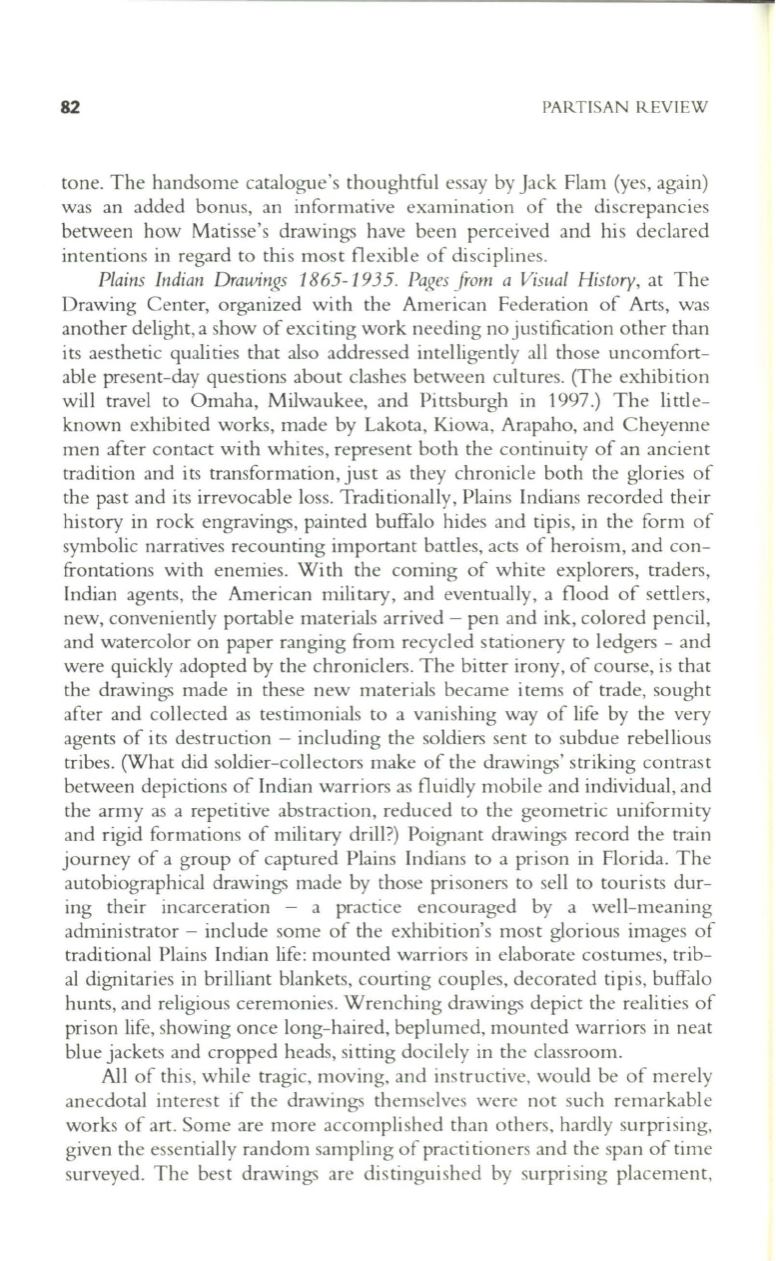
82
PARTISAN REVIEW
tone. The handsome catalogue's thoughtful essay by Jack Flam (yes, again)
was an added bonus, an informative examination of the discrepancies
between how Matisse's drawings have been perceived and his declared
intentions in regard to this most flexible of disciplines.
Plains Indian Drawings
1865-1935.
Pages from a Visual History,
at The
Drawing Center, organized with the American Federation of Arts, was
another delight, a show of exciting work needing no justification other than
its aesthetic qualities that also addressed intelligently all those uncomfort–
able present-day questions about clashes between cultures. (The exhibition
will travel to Omaha, Milwaukee, and Pittsburgh in 1997.) The Iittle–
known exhibited works, made by Lakota, Kiowa, Arapaho, and Cheyenne
men after contact with whites, represent both the continuity of an ancient
tradition and its transformation, just as they chronicle both the glories of
the past and its irrevocable loss. Traditionally, Plains Indians recorded their
history in rock engravings, painted buffalo hides and tipis, in the form of
symbolic narratives recounting important battles, acts of heroism, and con–
frontations with enemies. With the coming of white explorers, traders,
Indian agents, the American military, and eventually, a flood of settlers,
new, conveniently portable materials arrived - pen and ink, colored pencil,
and watercolor on paper ranging from recycled stationery to ledgers - and
were quickly adopted by the chroniclers. The bitter irony, of course, is that
the drawings made in these new materials became items of trade, sought
after and collected as testimonials to a vanishing way of life by the very
agents of its destruction - including the soldiers sent to subdue rebellious
tribes. (What did soldier-collectors make of the drawings' striking contrast
between depictions of Indian warriors as fluidly mobile and individual, and
the army as a repetitive abstraction, reduced to the geometric uniformity
and rigid formations of military drill?) Poignant drawings record the train
journey of a group of captured Plains Indians to a prison in Florida. The
autobiographical drawings made by those prisoners to sell to tourists dur–
ing their incarceration - a practice encouraged by a well-meaning
administrator - include some of the exhibition's most glorious images of
traditional Plains Indian life: mounted warriors in elaborate costumes, trib–
al dignitaries in brilliant blankets, courting couples, decorated tipis, buffalo
hunts, and religious ceremonies. Wrenching drawings depict the realities of
prison life, showing once long-haired, beplumed, mounted warriors in neat
blue jackets and cropped heads, sitting docilely in the classroom.
All of this, while tragic, moving, and instructive, would be of merely
anecdotal interest if the drawings themselves were not such remarkable
works of art. Some are more accomplished than others, hardly surprising,
given the essentially random sampling of practi tioners and the span of time
surveyed. The best drawings are distinguished by surprising placement,


